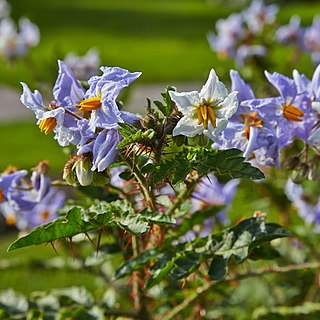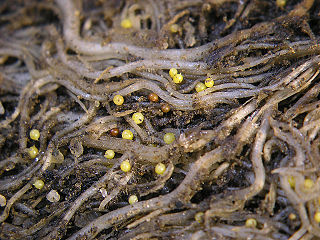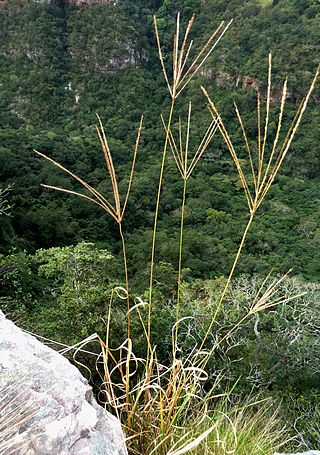
Cystic fibrosis (CF) is a rare genetic disorder that affects mostly the lungs, but also the pancreas, liver, kidneys, and intestine. Long-term issues include difficulty breathing and coughing up mucus as a result of frequent lung infections. Other signs and symptoms may include sinus infections, poor growth, fatty stool, clubbing of the fingers and toes, and infertility in most males. Different people may have different degrees of symptoms.

Manihot esculenta, commonly called cassava, manioc, or yuca, is a woody shrub of the spurge family, Euphorbiaceae, native to South America, from Brazil and parts of the Andes. Although a perennial plant, cassava is extensively cultivated as an annual crop in tropical and subtropical regions for its edible starchy root tuber, a major source of carbohydrates. Cassava is predominantly consumed in boiled form, but substantial quantities are used to extract cassava starch, called tapioca, which is used for food, animal feed, and industrial purposes. The Brazilian farinha, and the related garri of West Africa, is an edible coarse flour obtained by grating cassava roots, pressing moisture off the obtained grated pulp, and finally drying it.

Plant pathology is the scientific study of diseases in plants caused by pathogens and environmental conditions. Organisms that cause infectious disease include fungi, oomycetes, bacteria, viruses, viroids, virus-like organisms, phytoplasmas, protozoa, nematodes and parasitic plants. Not included are ectoparasites like insects, mites, vertebrate, or other pests that affect plant health by eating plant tissues and causing injury that may admit plant pathogens. Plant pathology also involves the study of pathogen identification, disease etiology, disease cycles, economic impact, plant disease epidemiology, plant disease resistance, how plant diseases affect humans and animals, pathosystem genetics, and management of plant diseases.
Inorganic ions in animals and plants are ions necessary for vital cellular activity. In body tissues, ions are also known as electrolytes, essential for the electrical activity needed to support muscle contractions and neuron activation. They contribute to osmotic pressure of body fluids as well as performing a number of other important functions. Below is a list of some of the most important ions for living things as well as examples of their functions:

Cystic fibrosis transmembrane conductance regulator (CFTR) is a membrane protein and anion channel in vertebrates that is encoded by the CFTR gene.

Annona reticulata is a small deciduous or semi-evergreen tree in the plant family Annonaceae. It is best known for its fruit, called custard apple, a common name shared with fruits of several other species in the same genus: A. cherimola and A. squamosa. Other English common names include ox heart and bullock's heart. The fruit is sweet and useful in preparation of desserts, but is generally less popular for eating than that of A. cherimola.

Solanum sisymbriifolium is commonly known as vila-vila, sticky nightshade, red buffalo-bur, the fire-and-ice plant, litchi tomato, or Morelle de Balbis.

Meloidogyne arenaria is a species of plant pathogenic nematodes. This nematode is also known as the peanut root knot nematode. The word "Meloidogyne" is derived from two Greek words that mean "apple-shaped" and "female". The peanut root knot nematode, M. arenaria is one of the "major" Meloidogyne species because of its worldwide economic importance. M. arenaria is a predominant nematode species in the United States attacking peanut in Alabama, Florida, Georgia, and Texas. The most damaging nematode species for peanut in the USA is M. arenaria race 1 and losses can exceed 50% in severely infested fields. Among the several Meloidogyne species that have been characterized, M. arenaria is the most variable both morphologically and cytologically. In 1949, two races of this nematode had been identified, race 1 which reproduces on peanut and race 2 which cannot do so. However, in a recent study, three races were described. López-Pérez et al (2011) had also studied populations of M. arenaria race 2, which reproduces on tomato plants carrying the Mi gene and race 3, which reproduces on both resistant pepper and tomato.

Globodera rostochiensis, commonly known as the golden nematode, golden eelworm or yellow potato cyst nematode, is a plant pathogenic nematode. It is a pest of plants in the family Solanaceae, primarily infesting potatoes and tomatoes, as well as a variety of other root crops.

The Commonwealth Broadcasting Association (CBA) is a representative body for public service broadcasters throughout the Commonwealth, founded in 1945. A not-for-profit non-government organisation, the CBA is funded by subscriptions from 102 members and affiliates from 54 countries. The stated goal of the CBA is to promote best practices in public service broadcasting and to foster freedom of expression. It also serves to provide support and assistance to its members through training, bursaries, consultancies, networking opportunities and materials for broadcast.

The Connecticut Agricultural Experiment Station (CAES) is the Connecticut state government's agricultural experiment station, a state government component that engages in scientific research and public outreach in agriculture and related fields. It is the oldest state experiment station in the United States, having been founded in 1875. Its official mission is to "develop, advance, and disseminate scientific knowledge, improve agricultural productivity and environmental quality, protect plants, and enhance human health and well-being through research for the benefit of Connecticut residents and the nation." The station operates a main research campus in New Haven, a research farm in Hamden, a satellite research facility and farm in Windsor, and a research farm in Griswold. The Storrs Agricultural Experiment Station is a separate agricultural research agency, founded in 1887 and part of the University of Connecticut, which also receives state and federal funding.

The nematodesroundworms or eelworms, constitute the phylum Nematoda. They are a diverse animal phylum inhabiting a broad range of environments. Most species are free-living, feeding on microorganisms, but there are many that are parasitic. The parasitic worms (helminths) are the cause of soil-transmitted helminthiases.

Plant disease resistance protects plants from pathogens in two ways: by pre-formed structures and chemicals, and by infection-induced responses of the immune system. Relative to a susceptible plant, disease resistance is the reduction of pathogen growth on or in the plant, while the term disease tolerance describes plants that exhibit little disease damage despite substantial pathogen levels. Disease outcome is determined by the three-way interaction of the pathogen, the plant and the environmental conditions.

Purpureocillium lilacinum is a species of filamentous fungus in the family Ophiocordycipitaceae. It has been isolated from a wide range of habitats, including cultivated and uncultivated soils, forests, grassland, deserts, estuarine sediments and sewage sludge, and insects. It has also been found in nematode eggs, and occasionally from females of root-knot and cyst nematodes. In addition, it has frequently been detected in the rhizosphere of many crops. The species can grow at a wide range of temperatures – from 8 to 38 °C for a few isolates, with optimal growth in the range 26 to 30 °C. It also has a wide pH tolerance and can grow on a variety of substrates. P. lilacinum has shown promising results for use as a biocontrol agent to control the growth of destructive root-knot nematodes.

Protalix BioTherapeutics is an Israeli pharmaceutical company that manufactures a plant-based enzyme, taliglucerase alfa, which has received U.S. Food and Drug Administration approval for the treatment of Gaucher disease.

Digitaria eriantha, commonly known as digitgrass or Pangola-grass, is a grass grown in tropical and subtropical climates. It grows relatively well in various soils, but grows especially well in moist soils. It is tolerant to droughts, water lodging, suppresses weeds and grows relatively quickly after grazing. This grass demonstrates great potential for farmers in Africa in subtropical and tropical climates, mostly for livestock feed.

Maris Piper is the most widely grown potato variety in the United Kingdom accounting for 16% of the planted area in 2014. Introduced in 1966 it was one of the first potato varieties bred to be resistant to a form of potato cyst nematode, a major pest of potato production in the UK. It has been the most widely grown variety in the UK since 1980 and is suitable for a range of uses including chips, roast potatoes and mashed potatoes.

Hanoch Senderowitz is an Israeli chemist specializing in the fields of Computational Chemistry, Molecular modelling, Computer-Aided Drug Design, and Chemoinformatics.
















